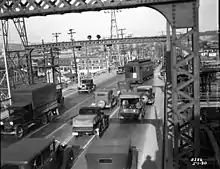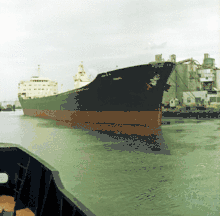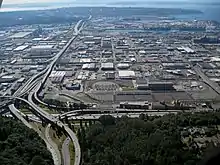West Seattle Bridge
The high-level West Seattle Bridge, officially the Jeanette Williams Memorial Bridge, is a cantilevered segmental bridge that serves as the primary connection between West Seattle and the rest of the city. It was built between 1981 and 1984 after the previous bascule bridge was deemed inoperable as a result of being struck by the freighter Antonio Chavez in 1978.
West Seattle Bridge | |
|---|---|
 The West Seattle Bridge from the west side, seen during a closure in 2020 | |
| Coordinates | 47.570945°N 122.350338°W |
| Carries | 7 lanes |
| Crosses | Duwamish Waterway |
| Locale | Seattle, Washington |
| Other name(s) | Jeanette Williams Memorial Bridge |
| Characteristics | |
| Design | segmental, cantilever |
| Total length | 2,607 ft (795 m)[1] |
| Clearance below | 140 ft (42.6 m) |
| History | |
| Designer | Andersen Bjornstad Kane Jacobs, Inc.[2] |
| Opened | July 14, 1984[3] |
| Closed | March 23, 2020 |
| Location | |

| |
The bridge spans the east and west channels that form the mouth of the Duwamish River at Elliott Bay, crossing over Harbor Island. Its main approaches are Fauntleroy Way S.W. from the west and the Spokane Street Viaduct from the east. The viaduct continues east to Interstate 5 at Columbian Way (exit 163), forming a three-mile (5 km) arterial between West Seattle and I-5. The navigational clearance height of the high-level West Seattle Bridge is 140 feet (42.6 meters).[4]
The low-level Spokane Street Bridge of swing-span design spans the west channel of the Duwamish River immediately north of the high-level bridge. The low-level bridge carries the surface-level Spokane Street and has a navigational clearance of 45 feet (13.7 meters).
The bridge was closed in March 2020 after cracks in the underside were found to be growing rapidly, necessitating a major repair amid the COVID-19 pandemic. SDOT has since announced that the bridge will remain closed until at least 2022.
History
West Spokane Street Bridge

The bridge that preceded the "West Seattle Bridge" as we know it today was called the "West Spokane Street Bridge".[5] "Spokane Street" has long been used as designation for the streets running along the latitude of the current West Seattle Bridge.[6] Before any permanent bridge was built along the line of Spokane Street, there had been three temporary bridges, built c. 1900, c. 1910, and c. 1918. The first one was basically a swinging gate in what had been primarily built as a water main; the second was a swing bridge that also carried a water main, and the third was a swing bridge after the water main had been rerouted elsewhere.[7]
A more permanent bascule bridge was constructed in 1924, which lasted for several decades. In 1945, one of Seattle's oldest freeways (the "Spokane Street Viaduct") connected the bridge to Beacon Hill. Prior to the construction of Interstate 5 in Washington, the viaduct was separated from the bridge by the main north-south corridor: U.S. Route 99 in Washington.
By the 1970s, the West Spokane Street Bridge was one of Seattle's worst bottlenecks, due to the large number of ships in Duwamish Waterway and the frequent bridge openings. City leaders began planning a higher bridge, without a drawbridge, in the 1960s.
Replacement bridge project
Planning for the bridge was hampered by difficulties in receiving funding. In large part, this is because the bridge was not a designated highway. A 1968 Forward Thrust ballot measure included $16.7 million in funding for the bridge, largely to receive votes from West Seattle residents. Other funding sources included a state program for funding urban streets and money from a maintenance fund.
After a long drawn-out process, three companies eventually bid to design the bridge for $1.5 million. However, the city engineer chose a fourth company that was financially connected to the speaker of the state house. The price from this fourth company was triple the cost of the other three. This was a result of a series of bribes involving the head of the House Transportation Committee, the city engineer and others. Despite the 68 percent support in the 1968 ballot measure, the state withdrew its urban streets money due to the scandal. In 1976 and 1977, the conspirators were placed on trial and imprisoned.
After the scandal, the project was considered dead. Norbert Tiemann, a federal highway regulator, stated that there would essentially be no chance of the project receiving federal funds for completion. Tiemann also quipped, "Short of a tug knocking it down (which could trigger federal special bridge replacement funds), there is nothing else. And you certainly wouldn't want to go that route."[8] In March 1978, several prominent West Seattle residents filed a petition to organize a secession referendum, with the hopes of finding state funding for a new bridge to serve their independent city.[9] The secession campaign was required to gather 29,000 signatures for a ballot measure, but were unable to meet the threshold before the drawbridges were permanently closed two months later.[9][10]
1978 closure

On June 11, 1978, a ship struck the old bridge, which left it open and unrepairable. Because of this, the project qualified for funds from the federal Office of Special Bridge Replacement. However, with many other damaged bridges to replace, this program alone did not have sufficient funding. While federal lawmakers were opposed to appropriating funds to a high-level bridge, Seattle City Council member Jeanette Williams, who served on the council from 1970 to 1989, lobbied Congress for the bridge and successfully secured funds with help from Senator Warren Magnuson.[11][12] The smaller Spokane Street Bridge which parallels it was built at the same time. Before the bridge opened, many of the neighborhoods in West Seattle had low property values because of the difficulty in getting downtown.
Jeanette Williams Memorial Bridge
The replacement bridge was opened in 1984.[11][12] The West Seattle Bridge was renamed as the Jeanette Williams Memorial Bridge on July 6, 2009, in honor of councilmember Williams, who had been instrumental in securing political support for the construction of the bridge.[11][12] All directional signs still carry the name "West Seattle Bridge", many of which had formerly borne the designation "West Seattle Freeway".
The bridge caused an increase in property values as well as a development boom, as developers constructed new multi-family housing. This new development also led to an increase in traffic volumes throughout the neighborhood.

A monorail extension to West Seattle in the early 2000s was planned to use the West Seattle Bridge, with elevated columns over the center barrier.[13] The plan was later scaled down to a single-track guideway over the bridge and abandoned entirely in 2005 over cost concerns.[14][15]
2020 closure

On March 23, 2020, SDOT began a long-term closure of the bridge for emergency repairs after cracks in the deck were discovered during a routine inspection.[16][17] The girder wall cracks had grown to 2 feet (0.61 m) within a month, while the hollow girder cracks had been noticed during inspections. An earlier report from 2014 speculated that earlier cracks had been caused by the 2001 Nisqually earthquake.[18] On April 15, SDOT announced that the bridge will be closed until at least 2022 because of more extensive damage found and estimated time to complete bracing for the repair project.[19] Following the closure of the bridge, some people, including Seattle-based architectural firm Wittman Estes called for the bridge to be replaced,[20] but in November 2020, mayor Jenny Durkan said that the city would continue focusing on repair rather than any replacement.[21]
West Seattle Freeway

The Spokane Street Viaduct section was one of Seattle's first freeways, built in 1945. Upon completion of the West Seattle Bridge in 1984, the road comprising the Spokane Street Viaduct and the West Seattle Bridge was referred to as the "West Seattle Freeway". However, a series of fatalities led to recognition that the aging Spokane Street Viaduct portion was unsafe to be used as a high-speed roadway.[22] In 1997, the Seattle City Council unanimously adopted a resolution to lower the speed limit and to request that the WSDOT remove the word "Freeway" from signs marking the entrances to the Spokane Street Viaduct and the West Seattle Bridge.[23][24] The West Seattle Bridge was renamed as the Jeanette Williams Memorial Bridge on July 6, 2009, in honor of councilmember Williams, who had been instrumental in securing political support for the construction of the bridge.[11][12] However, all directional signs continue to carry the name "West Seattle Bridge."
From 2008 to 2013, the Spokane Street Viaduct section between Interstate 5 and State Route 99 was rebuilt and widened. The widened roadway has three lanes in each direction and shoulders. A new westbound on and off ramp was built at 1st Ave S and replaced the dangerous 4th Ave S off-ramp. A new eastbound off-ramp to 4th Ave S opened August 16, 2010.
Exit list
| Destinations | Notes |
|---|---|
| Fauntleroy Way Southwest, 35th Avenue Southwest | Ends at an at-grade intersection |
| Admiral Way | Westbound exit and eastbound entrance |
| Harbor Avenue, Avalon Way | Westbound exit and eastbound entrance |
| Delridge Way Southwest, Southwest Spokane Street - South Seattle College | Westbound exit and eastbound entrance |
| 11th Avenue Southwest - Harbor Island, Terminal 18 | Westbound exit and eastbound entrance |
| Eastbound exit and westbound entrance | |
| 1st Avenue South | Eastbound exit; westbound exit and entrance |
| 4th Avenue South | Eastbound exit |
| Spokane Street, 6th Avenue South | Westbound exit and eastbound entrance |
| Columbian Way, 15th Avenue South | Eastbound exit and westbound entrance |
See also
- Spokane Street Bridge, the "low" bridge that makes the same crossing.
Notes
- "West Seattle Bridge Ceremonially Renamed the "Jeanette Williams Memorial Bridge"" (Press release). Seattle City Council. October 23, 2009. Retrieved July 3, 2011.
- Kane, Thomas; Carpenter, James; Clark, John (November–December 1983). "Approach Spans to the West Seattle Bridge" (PDF). PCI Journal. 28 (6): 58–67. Archived (PDF) from the original on April 1, 2020.
- Long, Priscilla (May 29, 2007). "West Seattle Bridge is dedicated on July 14, 1984". HistoryLink. Retrieved August 22, 2014.
- "U.S. Coast Guard Bridge Guide Clearances".
- "Ship Runs Into Seattle Bridge (Published 1978)". The New York Times. June 12, 1978. ISSN 0362-4331. Retrieved December 30, 2020.
- images, Derivative work by Joe Mabel, using public domain (August 1, 2009), A map of Seattle in 1909, created by combining portions of the following public domain images:, retrieved December 23, 2020
- Paul Dorpat (1984). "100 - Six Bridges to West Seattle". Seattle Now and Then. Tartu.
- Bob Royer (June 20, 2011). "When the Ship Hit the Span". Cascadia Courier. Retrieved May 26, 2014.
- Eals, Clay (May 21, 2020). "For West Seattle's bridge, if at first you don't succeed, secede!". The Seattle Times. Retrieved May 21, 2020.
- Suffia, David (May 10, 1978). "West Seattle secession drive progressing slowly". The Seattle Times. p. A18.
- "You can call it the Jeanette Williams Memorial Bridge". WestSeattleBlog, 23 October 2009.
- "West Seattle Bridge renamed to honor Jeanette Williams". West Seattle Herald, 23 October 2009.
- Lange, Larry (May 21, 2004). "Engineer raises monorail concerns". Seattle Post-Intelligencer. p. A1.
- Lindblom, Mike (July 20, 2005). "Officials consider phased-in monorail". The Seattle Times. p. B1.
- Lange, Larry (November 9, 2005). "No monorail: Voters reject shortened line". Seattle Post-Intelligencer. p. A1.
- Lindblom, Mike (March 23, 2020). "West Seattle Bridge closes tonight for repairs that could take months". The Seattle Times. Retrieved March 23, 2020.
- Davis, Sara (March 25, 2020). "Alternate Routes for West Seattle High-rise Bridge closure". SDOT Blog. Retrieved December 22, 2020.
- Lindblom, Mike (April 9, 2020). "West Seattle Bridge was on a road to collapse, engineers' reports show". The Seattle Time. Retrieved April 9, 2020.
- Lindblom, Mike; Groover, Heidi (April 15, 2020). "West Seattle Bridge will stay closed through 2020 and 2021". The Seattle Times. Retrieved April 15, 2020.
- "This year's virtual design festival will include 'Duwamish Crossings' proposal". Seattle Daily Journal of Commerce. Seattle. August 12, 2020. Retrieved December 29, 2020.
- "Community relieved by decision that could repair West Seattle Bridge by mid-2022". KING-TV. Seattle. November 19, 2020. Retrieved December 29, 2020.
- "Spokane St. Viaduct: Aging Relic Among Modern Highways -- 10 Die In Crashes Since '87". Seattle Times. June 10, 1993. Retrieved March 24, 2020.
- Brown, Charles E. (April 7, 2008). "Bumper to Bumper: Dalai Lama, Bus a miss, Name that bridge". The Seattle Times. p. B1. Archived from the original on May 28, 2018. Retrieved May 27, 2018.
- Seattle City Council (March 3, 1997). "City of Seattle Resolution 29541". City of Seattle Legislative Information Service. Office of the City Clerk. Retrieved May 27, 2018.
External links
| Wikimedia Commons has media related to West Seattle Bridge. |
